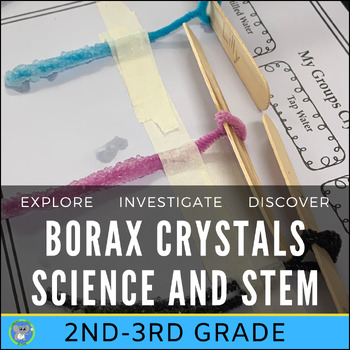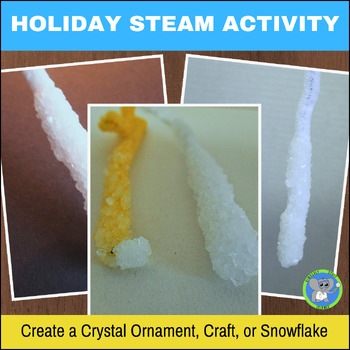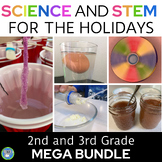Christmas Science Activity | Borax Crystal Growth Experiment | Grade 2 3
- PDF
Also included in
- Bundle and SAVE on this collection of our favorite science and STEM Activities for holidays. You will get 7 project-based units that are popular for Halloween, Thanksgiving, Christmas, Valentine's, Saint Patrick's Day, and Easter. They meet the standards and can be used anytime, too!Each Unit IncluPrice $32.92Original Price $41.15Save $8.23
- A Complete 2nd-8th Grade Crystal Science and STEM unit. Differentiated worksheets save you time with lesson planning. Materials are inexpensive and results in 24 hours. Teacher guide and alignment to NGSS included. Students will discover borax crystal formation with a memorable hands-on lab and SPrice $11.40Original Price $14.25Save $2.85
Description
Discover mixtures and solutions by growing borax crystals. You'll get a comprehensive teacher guide, hands-on investigation, and borax ornament STEAM challenge. This unit uses inexpensive materials and gives results in 24 hours. A wonderful way to practice the scientific method, measuring mass, and graphing for the holiday season.
This Hands-On Investigation and Teacher Guide Includes
- Teacher Guide with Background Information and Tips
- Alignment to Standards
- 6-Page Student Investigation Journal
- STEAM Crystal Creation Worksheet and Activity
- Rubric
- Answer Key
- Terms of use
This investigation meets the Next Generation Science Standards
- Structure and Properties of Matter Alignment 2nd Grade
- K-2 Science and Engineering Practices
- 3-5 Science and Engineering Practices
Storybook Connection: Before performing the STEAM craft, read "Snowflake Bentley" by Jacqueline Briggs Martin and illustrated by Mary Azarian. This may motivate and give students ideas for snowflake shapes for their crystals. (Purchase the book separately or get it at the library.)
Students will test how different types of water affect crystal growth. They will create supersaturated solutions and discover that distilled water is a pure substance and other types of water may not be. In the investigation, the students will follow the scientific method to create a hypothesis, record data, and create a graph. Students will be guided on using their evidence to write a summary and conclusion. Word boxes and labels guide and differentiate for this grade level. Students will use their knowledge from the lab to create a crystal design, Christmas ornament, or snowflake.
Teachers will love the step-by-step directions, journal layout, and taking crystal making to another level. This is an excellent activity for science fairs, classrooms, clubs, or science camps. All supplies can be found at the grocery store. It only takes 24 hours for results!
Supplies: Borax Powder, Tap Water, Distilled Water, Mineral Water, Popsicle Sticks, Pipe Cleaners, Heat Resistant Plastic or Glass Jars, Spoons, Measuring Spoons, and Measuring Cups. All supplies can be found at the grocery store. You will need a scale for weighing the crystals.
Important: Borax crystals may sometimes stick to the container and be impossible to get off. Heat-proof plastic containers clean the best, or use something disposable. If you use a glass beaker, test one first to see what happens.
This investigation is part of a series. This is the 2nd/3rd-grade version. Please click each grade level version below to see more details.
Borax Crystal Lab: Investigate the Type of Water on Crystal Growth Grade 4/5
Borax Crystal Lab: Investigate the Type of Water on Crystal Growth Grade 6,7,8
Do you need multiple grade-level versions as a science lab teacher or for differentiation? Purchase the Bundle and save 20% on each resource.
STEAM Lab: Borax Crystal Lab: 3 Grade Level Bundle
You might also like
Science Fair Project Guide: Create Original Investigations with 2nd/3rd Grade
Freezing And Melting Points: Dangling Ice Investigation For 2nd/3rd Grade
Properties Of Matter Exploration: An Egg-cellent Exploration
Remember, leaving feedback earns you points toward FREE TPT purchases. We love hearing how the investigation went.
Also, follow us and be notified when new explorations are uploaded and deals.
Please contact us with any questions. We are here to help.
Yours in Science,
Kimberly Scott
Inspiring Lifelong Learnings through a Memorable Scientific Experience
All parts are copyrighted. Please see the terms of use in the download. Please use good lab practices. The seller is not responsible for the use or misuse of the activities.







